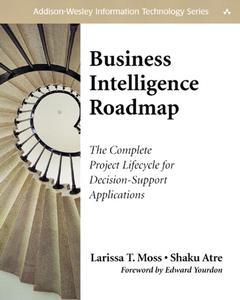Business intelligence roadmap : the complete project lifecycle for decision support applications (with CD-Rom)
Langue : Anglais
Auteurs : MOSS Larissa, ATRE Shaku

This book is a visual guide to developing an effective business intelligence (BI) decision-support application. This book outlines a methodology that takes into account the complexity of developing applications in an integrated BI environment. The authors walk readers through every step of the process--from strategic planning to the selection of new technologies and the evaluation of application releases. The book also serves as a single-source guide to the best practices of BI projects. Part I steers readers through the six stages of a BI project: justification, planning, business analysis, design, construction, and deployment. Each chapter describes one of sixteen development steps and the major activities, deliverables, roles, and responsibilities. All technical material is clearly expressed in tables, graphs, and diagrams. Part II provides five matrices that serve as references for the development process charted in Part I. Management tools, such as graphs illustrating the timing and coordination of activities, are included throughout the book. The authors conclude by crystallizing their many years of experience in a list of dos, don'ts, tips, and rules of thumb. The accompanying CD-ROM includes a complete, customizable work breakdown structure. Both the book and the methodology it describes are designed to adapt to the specific needs of individual stakeholders and organizations. The book directs business representatives, business sponsors, project managers, and technicians to the chapters that address their distinct responsibilities. The framework of the book allows organizations to begin at any step and enables projects to be scheduled and managed in a variety of ways.
About the Authors. Foreword. Preface. The Purpose of This Book. Complexity. Step-by-Step Guide. How This Book Is Organized. Part I: Stages and Steps. Part II: At a Glance. How to Use This Book. Who Should Read This Book. Business Representatives. Business Sponsors. Project Managers. Technicians. Comments. Part 1: STAGES AND STEPS.. 0. Guide to the Development Steps. Business Intelligence Definition. BI Decision-Support Initiatives. Development Approaches. The Traditional Development Approach. The Cross-Organizational Development Approach. Engineering Stages and the Development Steps. Parallel Development Tracks. BI Project Team Structure. The Core Team. The Extended Team. The BI Arbitration Board. Justification for Using This Project Lifecycle Guide. Bibliography and Additional Reading. 1. Step 1: Business Case Assessment. Business Justification. Business Drivers. Business Analysis Issues. Information Needs. Types of Data Sources. Source Data Quality. Cost-Benefit Analysis. Risk Assessment. Business Case Assessment Activities. Deliverable Resulting from These Activities. Roles Involved in These Activities. Risks of Not Performing Step. Bibliography and Additional Reading. 2. Step 2: Enterprise Infrastructure Evaluation. Step 2, Section A: Technical Infrastructure Evaluation. The Hardware Platform. Controlled Chaos. Hardware Platform Requirements. The Middleware Platform. DBMS Gateways. The DBMS Platform. Criteria for Selecting a DBMS. Technical Infrastructure Evaluation Activities. Deliverables Resulting from These Activities. Roles Involved in These Activities. Risks of Not Performing Step 2, Section A. Step 2, Section B: Nontechnical Infrastructure Evaluation. The Effects of Stovepipe Development. The Need for Nontechnical Infrastructure. Enterprise Architecture. Enterprise Standards. Nontechnical Infrastructure Evaluation Activities. Deliverable Resulting from These Activities. Roles Involved in These Activities. Risks of Not Performing Step 2, Section B. Bibliography and Additional Reading. Technical Infrastructure Evaluation. Nontechnical Infrastructure Evaluation. 3. Step 3: Project Planning. Managing the BI Project. Defining the BI Project. Project Goals and Objectives. Project Scope. Project Risks. Project Constraints. Assumptions. Change-Control Procedures. Issues Management Procedures. Planning the BI Project. Activities and Tasks. Estimating Techniques. Resource Assignment. Task Dependencies. Resource Dependencies. Critical Path Method. Project Schedules. Project Planning Activities. Deliverables Resulting from These Activities. Roles Involved in These Activities. Risks of Not Performing Step 3. Bibliography and Additional Reading. 4. Step 4: Project Requirements Definition. General Business Requirements. Interviewees for General Business Requirements. Data Quality Requirements. Business Requirements Report . Project-Specific Requirements. Interviewees for Project-Specific Requirements. Application Requirements Document. The Interviewing Process. Interviewing Considerations. Interviewing Tips. Project Requirements Definition Activities. Deliverable Resulting from These Activities. Roles Involved in These Activities. Risks of Not Performing Step 4. Bibliography and Additional Reading. 5. Step 5: Data Analysis. Business-Focused Data Analysis. Top-Down Logical Data Modeling. Project-Specific Logical Data Model. Enterprise Logical Data Model. Logical Data Modeling Participants. Standardized Business Meta Data. Bottom-Up Source Data Analysis. Technical Data Conversion Rules. Business Data Domain Rules. Business Data Integrity Rules. Data Cleansing. Data Quality Responsibility. Source Data Selection Process. Key Points of Data Selection. To Cleanse or Not to Cleanse. Cleansing Operational Systems. Data Analysis Activities. Deliverables Resulting from These Activities. Roles Involved in These Activities. Risks of Not Performing Step 5. Bibliography and Additional Reading. 6. Step 6: Application Prototyping. Purposes of Prototyping. Time-Boxing. Best Practices for Prototyping. Considerations for Prototyping. Types of Prototypes. Show-and-Tell Prototype. Mock-Up Prototype. Proof-of-Concept Prototype. Visual-Design Prototype. Demo Prototype. Operational Prototype. Building Successful Prototypes. Prototype Charter. Guidelines for Prototyping. Skills Survey. Application Prototyping Activities. Deliverables Resulting from These Activities. Roles Involved in These Activities. Risks of Not Performing Step 6. Bibliography and Additional Reading. 7. Step 7: Meta Data Repository Analysis. The Importance of Meta Data. Meta Data Categories. Meta Data Repository as Navigation Tool. Data Standardization. Meta Data Classifications. Groupings of Meta Data Components. Prioritization of Meta Data Components. Meta Data Repository Challenges. Technical Challenges. Staffing Challenges. Budget Challenges. Usability Challenges. Political Challenges. The Logical Meta Model. The Entity
Date de parution : 03-2003
Ouvrage de 542 p.
19x23 cm
Thème de Business intelligence roadmap : the complete project... :
© 2024 LAVOISIER S.A.S.
